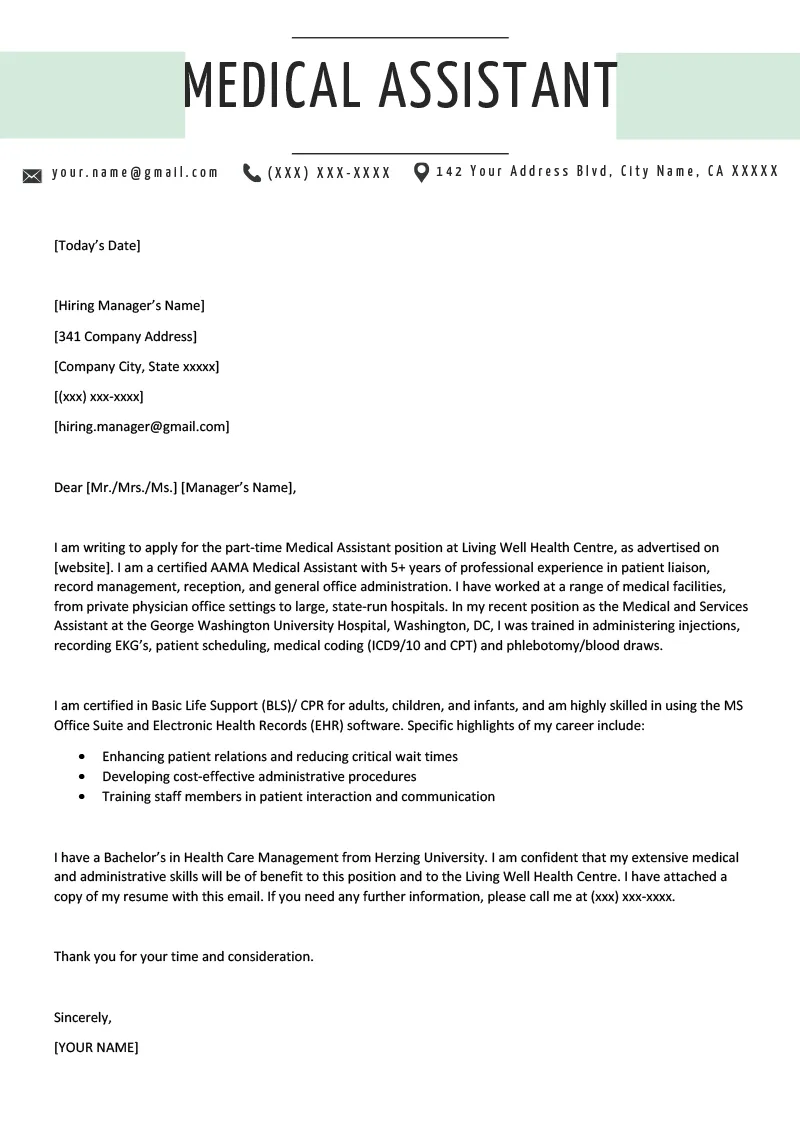Understanding the Importance of a Medical Assistant Cover Letter
A medical assistant cover letter is far more than just a formality; it’s your first and often most crucial opportunity to make a strong impression on a potential employer. In a competitive job market, a well-crafted cover letter can be the deciding factor in whether your application gets a second look. It allows you to go beyond the constraints of your resume, providing context, showcasing your personality, and articulating your passion for the medical field. This document isn’t just about listing your qualifications; it’s about telling a story—a story that highlights how your skills and experiences align with the specific needs of the employer. A compelling cover letter demonstrates your professionalism, attention to detail, and genuine interest in the position, setting you apart from other applicants. By investing time and effort into crafting a standout cover letter, you significantly increase your chances of securing an interview and ultimately, landing your dream job.
Key Components of a Medical Assistant Cover Letter
A successful medical assistant cover letter comprises several essential elements, each playing a vital role in capturing the reader’s attention and conveying your qualifications. Firstly, the header should include your contact information, ensuring the employer can easily reach you. Next, you’ll need to address the hiring manager directly, which shows initiative and attention to detail. The opening paragraph should be compelling, immediately grabbing the reader’s interest by expressing your enthusiasm for the role and highlighting your key strengths. The body of the letter is where you detail your skills and experience, aligning them with the job requirements, and providing specific examples of your accomplishments. You must remember to keep the language professional and specific to your experiences. You should then tailor your letter to the specific job by referencing the job description. Your closing paragraph should reiterate your interest, express gratitude, and outline your next steps, such as offering to provide any additional information they may need. Finally, the letter must be free of errors, neatly formatted, and visually appealing.
Your Header Information
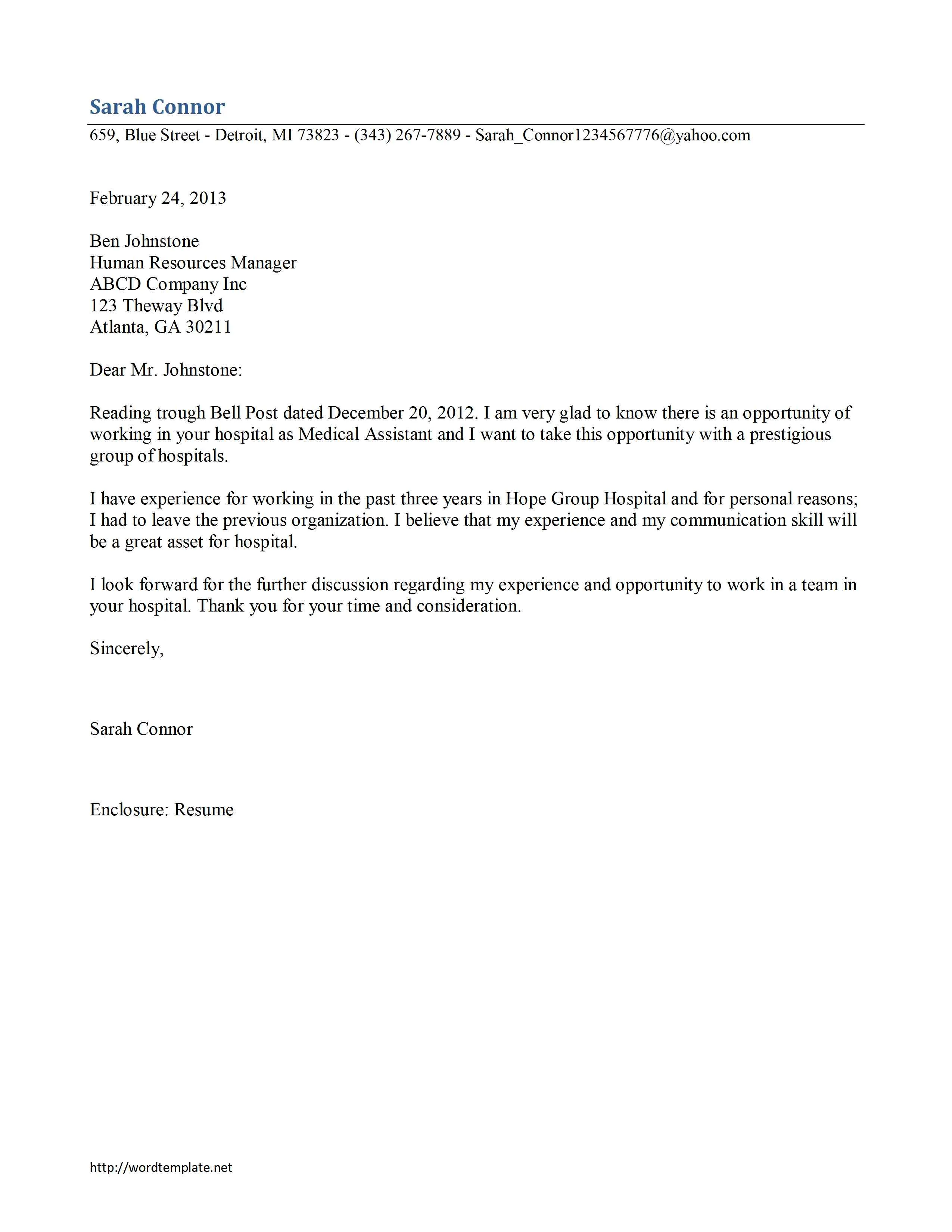
The header of your medical assistant cover letter is the first piece of information a potential employer sees, making it essential to get it right. Your header should clearly display your full name, ensuring easy identification. Include your complete mailing address, providing a professional touch and allowing the employer to reach you via mail if necessary. It’s critical to include your phone number, ensuring the employer has a direct line of communication to schedule interviews or ask follow-up questions. Lastly, your email address should be included, using a professional and easily readable email. Make sure you use a professional-sounding email address, preferably one that includes your name. Double-check all the information for accuracy to avoid any communication barriers.
Date and Contact Information
Below your header, start by including the date you are writing the letter. It shows the timeliness of your application. Following the date, provide the recipient’s information. If you are sending a letter in response to a specific job posting, this section should include the hiring manager’s name, title, the name of the clinic or healthcare facility, and its address. If you do not know the hiring manager’s name, research the company website or LinkedIn to find the correct person. Ensuring accuracy in this part of your letter demonstrates your attention to detail and your genuine interest in the position. A well-formatted and correctly addressed letter increases the chances of making a positive first impression.
Addressing the Hiring Manager
Addressing the hiring manager directly is a crucial step in creating a strong impression, and is often overlooked. Instead of using generic greetings like ‘To Whom It May Concern,’ research the hiring manager’s name and title. This shows initiative and a personalized approach. If the job posting doesn’t specify, look up the contact information on the clinic’s website or on professional networking sites. Use formal salutations such as ‘Dear Mr./Ms./Dr. [Last Name]’ to maintain a professional tone. Be sure to double-check the spelling of their name, and title to avoid errors that can create a negative impression. This personal touch shows you have put in the effort to learn about the company and its leadership, making your cover letter stand out from a pile of generic applications.
Crafting a Compelling Opening

Your opening paragraph is the first chance to hook the reader, so it needs to be impactful. Avoid generic phrases; instead, immediately state the position you’re applying for and where you found the job listing. Then, succinctly highlight your most relevant skills and experience, the elements that align with the job description. For instance, start by expressing your enthusiasm for the medical assistant position at a specific clinic, then add that you have five years of experience in a similar role, along with specific clinical skills such as phlebotomy and patient intake. Consider adding a sentence that clearly expresses your understanding of the clinic’s mission or the patient-care approach. By immediately showcasing your qualifications and demonstrating your genuine interest, you capture the hiring manager’s attention and encourage them to read the rest of your letter.
Highlighting Your Skills and Experience
The core of your cover letter is the section where you showcase your skills and experience. Divide this section into concise paragraphs, each focusing on a specific area or skillset relevant to the medical assistant position. Use the job description as your guide. The more closely you can match your skills to the requirements in the job posting, the better. Do not just list your skills; provide concrete examples of how you’ve applied them in past roles. Use action verbs to describe your accomplishments and quantify your achievements whenever possible. For example, instead of saying, ‘Managed patient appointments,’ write, ‘Managed a schedule of 50+ patient appointments daily, reducing wait times by 15%.’ This approach gives the hiring manager tangible evidence of your capabilities.
Clinical Skills
Detail your clinical skills, showcasing your ability to perform essential tasks. Mention your experience with vital signs, such as taking temperature, pulse, blood pressure, and respiratory rate. Highlight your proficiency in assisting with examinations, including preparing patients, setting up equipment, and providing support to the physician. Mention your experience in phlebotomy, including experience in collecting blood samples, labeling, and preparing specimens for laboratory testing. Mention any experience in administering medications, including injections. Include any experience in performing basic laboratory tests such as urinalysis or glucose testing. Emphasize any experience with electronic health records (EHR) systems, including patient data entry, retrieval, and maintenance.
Administrative Skills
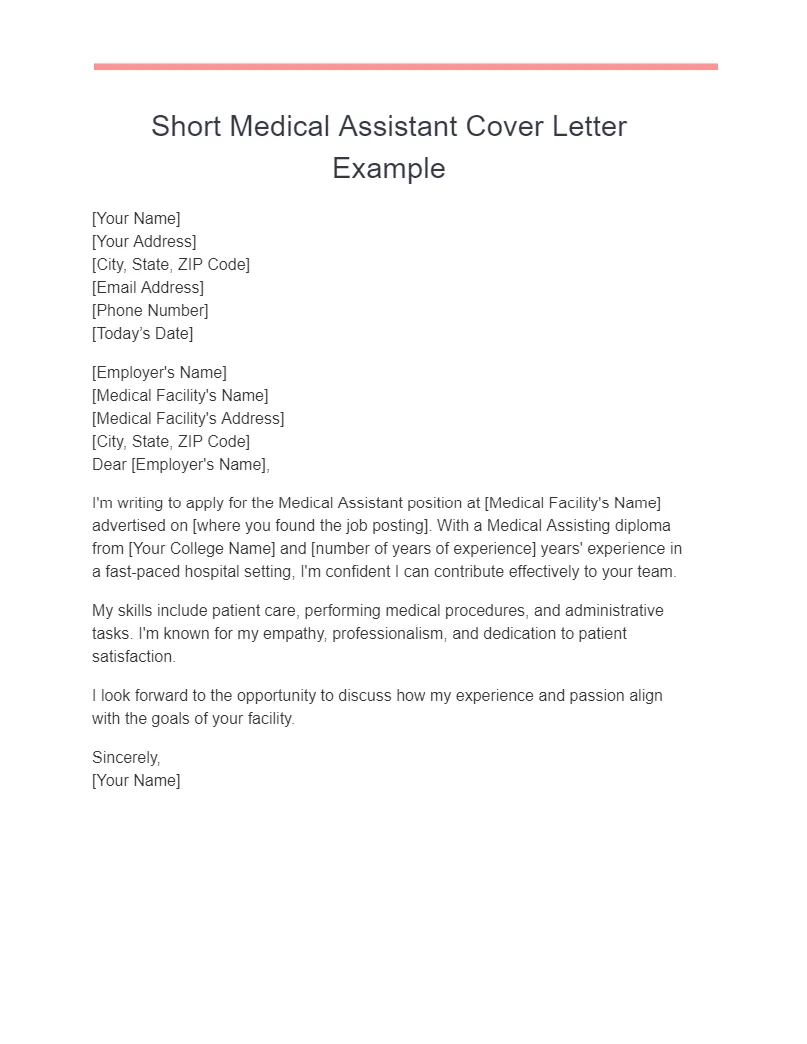
Highlight your administrative skills, showcasing your ability to perform essential office tasks. Describe your experience in scheduling appointments, emphasizing your ability to manage patient schedules and minimize wait times. Mention your experience in managing medical records, including patient data entry, maintenance, and confidentiality. Highlight your proficiency in handling insurance verification and billing, including experience in processing claims and resolving billing issues. Mention your experience in handling patient inquiries, including answering phone calls, responding to emails, and addressing patient concerns. Include your experience in managing office supplies and equipment.
Soft Skills
Showcase your soft skills to give a better impression to the recruiter. Mention your strong communication skills, including your ability to communicate effectively with patients, physicians, and other staff members. Highlight your ability to work as part of a team, including your experience in collaborating with healthcare professionals to provide patient care. Describe your experience in demonstrating empathy and compassion, including your ability to understand and respond to patient needs. Mention your experience in problem-solving and conflict resolution, including your ability to address patient concerns and resolve issues. Include your experience in demonstrating professionalism and maintaining patient confidentiality.
Demonstrating Your Passion and Enthusiasm
It’s crucial to demonstrate your passion for the medical field and your enthusiasm for the specific opportunity. Show that you’re not just looking for a job but a career. Research the clinic or healthcare facility to understand its mission, values, and patient care approach. Then, in your cover letter, subtly incorporate this knowledge. Explain why you’re interested in working for this particular organization and what aspects of their practice appeal to you. Share any personal experiences or insights that have fueled your desire to become a medical assistant. By articulating your passion, you make your cover letter more memorable and convey to the hiring manager that you’re a candidate who genuinely cares and is invested in the success of their practice.
Tailoring Your Letter to the Job Description
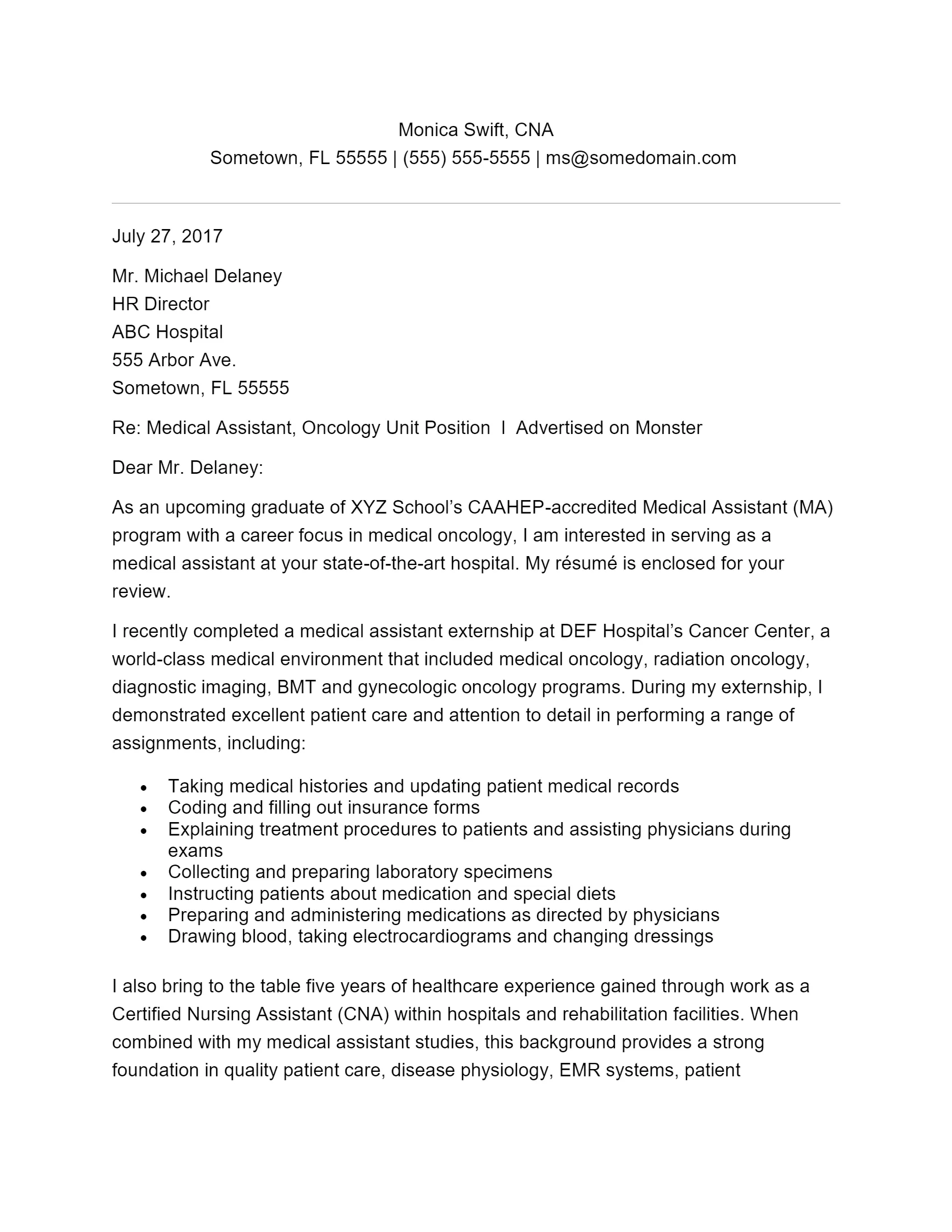
Customizing your cover letter for each application is essential for success. Before you start writing, carefully analyze the job description. Identify the key skills, experiences, and qualifications the employer seeks. Then, structure your cover letter to directly address those requirements. Make sure to use the keywords and phrases from the job description throughout your letter to highlight your relevant experience and skills. Where the job description emphasizes patient interaction, describe your interpersonal skills and any experience with patient care. If the role requires proficiency in a specific software or procedure, provide examples of your experience. This targeted approach will show the hiring manager that you understand the role and have the specific qualifications to excel in it, making your application stand out.
Researching the Employer
Demonstrate your commitment to the opportunity by researching the employer thoroughly. Visit the company website and read about their mission, values, and services. Explore their social media profiles to learn about their workplace culture and recent activities. If possible, look up the clinic’s or healthcare facility’s reputation and patient reviews to gauge their approach to patient care. This research will help you tailor your cover letter, and allows you to weave specific details about the organization into your letter. Doing so shows the hiring manager that you are genuinely interested in working for their organization. This can include mentioning specific aspects of their work that appeal to you, and demonstrate that you have a clear understanding of their goals. By showing that you have done your homework, you can set yourself apart from other candidates.
Using Keywords from the Job Posting
A critical step in crafting a compelling cover letter is incorporating keywords from the job posting. Carefully read the job description and identify the key skills, qualifications, and requirements listed. Then, seamlessly integrate these keywords throughout your cover letter. Use similar language to that in the job description. If the job description mentions ’experience with electronic health records (EHR) systems’, be sure to include your experience with specific EHR software, such as Epic or Cerner. Ensure the keywords are incorporated naturally into your writing, rather than crammed in awkwardly. This strategic use of keywords helps your cover letter pass through applicant tracking systems (ATS) and makes it clear to the hiring manager that you possess the skills and experience they seek.
Writing a Strong Closing
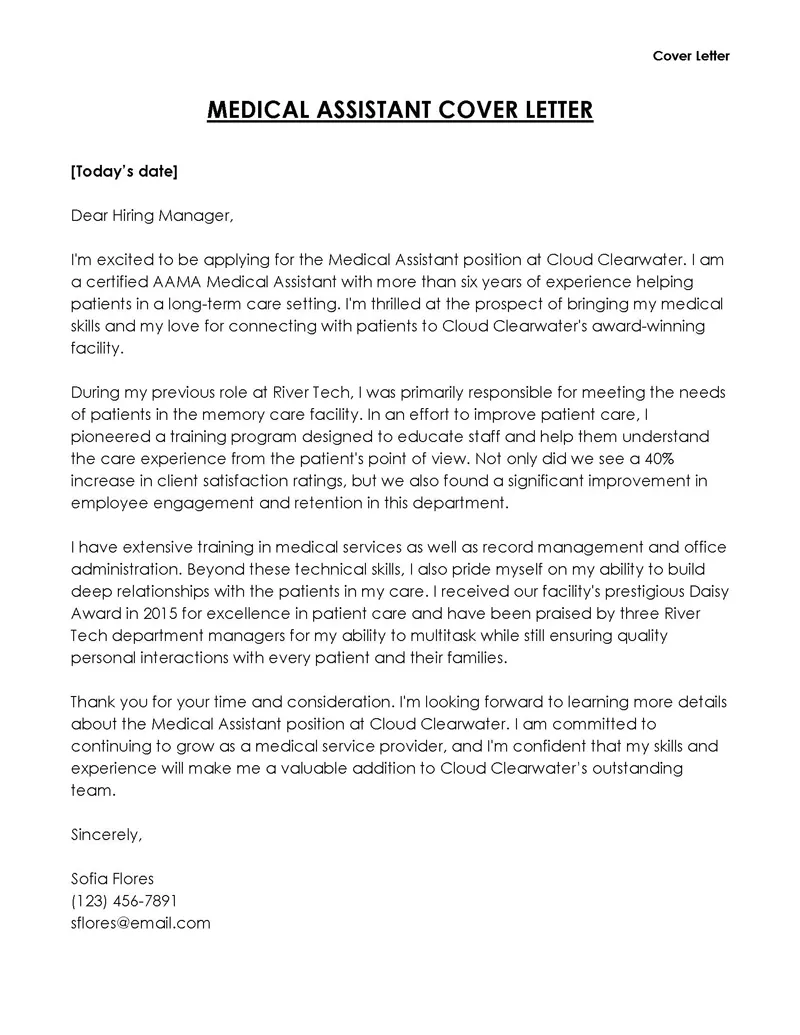
Your closing paragraph provides a final opportunity to leave a lasting impression. Reiterate your enthusiasm for the role and the clinic or healthcare facility. Reiterate your interest in the position and briefly summarize your key qualifications, reinforcing why you are a good fit. Express gratitude for the hiring manager’s time and consideration. Make sure to include a call to action. Provide your contact information and state your availability for an interview. For instance, write, ‘Thank you for your time and consideration. I am available for an interview at your earliest convenience and can be reached at [your phone number] or [your email address].’ Always proofread your closing for any grammatical errors. This final paragraph wraps up your application professionally and encourages the employer to take the next step.
Expressing Gratitude and Next Steps
Expressing gratitude and outlining the next steps is a vital part of the closing. Begin by thanking the hiring manager for their time and consideration. A sincere expression of appreciation sets a positive tone and reinforces your professionalism. Then, clearly state your availability for an interview. Provide your contact information again. Make it easy for the employer to reach you. Finally, you can express your eagerness to learn more about the position and the organization. Concluding this way shows your professionalism and proactively offers clear directions. This approach provides a smooth transition to the next phase of the hiring process, increasing the chances of your application moving forward.
Proofreading and Formatting
After completing your medical assistant cover letter, proofreading and formatting are essential steps that must not be overlooked. Carefully read your letter multiple times, checking for any typos, grammatical errors, or punctuation mistakes. A cover letter littered with errors can create a negative impression, implying a lack of attention to detail. Ensure consistent formatting throughout your letter, including font style, font size, and spacing. The layout should be clean and easy to read, and you should keep the tone of your writing professional and concise. It is a good idea to ask a friend, family member, or career counselor to review your cover letter, as a fresh set of eyes can catch errors you may have missed. Ensure that your final product is polished and reflects your professionalism.
Common Mistakes to Avoid

Certain mistakes can significantly undermine the effectiveness of your medical assistant cover letter. Avoid these common pitfalls to ensure your application stands out for the right reasons. Be sure to be familiar with the items listed below. By avoiding these errors, you will boost your chances of getting noticed, and increase your chances of getting hired.
Using Generic Language
Steer clear of generic language. Phrases that are overly general or cliché, such as ‘I am a hard worker’ or ‘I have excellent communication skills,’ are not enough. Instead, you should use specific examples to demonstrate your skills. Detail concrete accomplishments and tailor your language to reflect the specific requirements of the job. Be more specific than to merely state your capabilities. Instead, include the situations in which you have applied those skills. When detailing skills like communication, provide details. This creates a more compelling and memorable impression, making your cover letter stand out from the crowd.
Typos and Grammatical Errors
Careless typos and grammatical errors can detract from the professional image you aim to project. Proofreading is a critical step; always check for misspellings, incorrect punctuation, and grammatical inconsistencies before submitting your cover letter. Use spell-check and grammar-check tools, but also read the letter yourself and have a trusted friend or family member look it over as a final check. Typos can be perceived as a lack of attention to detail, a quality crucial in the medical field. A clean, error-free cover letter reflects your commitment to excellence and enhances your credibility, making a strong first impression.
Failing to Quantify Achievements

Avoid the common mistake of failing to quantify your achievements. Instead of vaguely stating your accomplishments, use numbers and metrics to provide concrete evidence of your skills and results. For instance, when describing your experience, be specific. For example, instead of saying that you improved patient intake processes, state that you ‘streamlined patient intake, reducing wait times by 20%.’ Quantifiable achievements demonstrate your value to potential employers, making your claims more persuasive and showing that you can contribute to their organization. Using data allows you to showcase the impact of your contributions more effectively.
Seeking Feedback and Reviewing Your Letter
Before submitting your cover letter, seek feedback from trusted sources. Ask a career counselor, professor, mentor, or someone with experience in hiring to review your letter. They can provide valuable insights on clarity, tone, and effectiveness, and identify any areas for improvement. Revise your cover letter based on the feedback. Tailor your letter to each job you apply for. Customizing it to align with the specific requirements of the position increases the chances of your application being noticed. The review and revision process ensures that your cover letter is polished, error-free, and tailored to the job.
